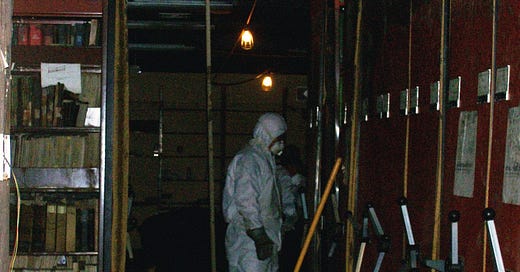Archival Disaster Recovery: “Hurricane Katrina and the Library” by Andy Corrigan
An Archivist's Reflection
ARTICLE: “Hurricane Katrina and the Library” by Andy Corrigan, November 2020
Tulane University’s Howard-Tilton Memorial Library suffered severely in the aftermath of Hurricane Katrina. The library, about the size of a football field, was flooded by more than 8 feet of water. The building housed a music library, a large collection of government records, newspapers, microfilm, as well as older books and journals. Jones Hall, just across the parking lot, was the building where the archives were housed. It was filled with over 4 feet of water.
The total amount of objects submerged in the Howard-Tolton include over 1.5 million books and folders of manuscripts, as well as another 1.5 million pieces of microform. In Jones Hall, over 700,000 original manuscripts and archival items, most of which were part of the library’s collection of Louisiana political papers and personal papers of prominent local figures, were submerged.
The BELFOR disaster management company, led by a small group of Tulane University archivists, began recovery while the city was still evacuated by all save for national guard and first responders. Four weeks after the storm, the groundwater had receded just enough to allow for the recovery of the lover levels of the buildings.
The recovery from Jones Hall was about 4,000 boxes with “everything of value.” These were mostly archival collections of historical manuscripts along with other primary source archival materials.
The Maxwell Music Library in the basement of the Howard Tilton originally held 43,000 titles in the form of books, scores, journals, CDs, and LPs. 70% of books and score materials were salvaged, but no recordings could be saved.
In the Government Documents area of the basement, the section that held the largest amount of print materials (500,000+ volumes), only 20% of materials were salvaged.
Of the microfilm materials, including 1.5 million individual pieces of microform and over 30,000 facsimiles of rare newspaper archives and scholarly material, only 5% was salvaged.
Another storage area that housed a mix of older volumes, geo-political reports, and government documents, as well as The Howard Collection, acquired in the 19th century as one of the university’s first library collections, was completely destroyed, leaving nothing salvageable.
One area that was completely salvaged for restoration were all 16,000+ items from a “protected storage area” that housed important works in art and photography (including many catalogues raisonnes) and a backlog of several thousand printed works that were still awaiting original cataloging that were “not held in other libraries.”
The overall number of items salvaged and restored are as follows: 300,000+ print volumes, 18,000+ reels of microfilm, and 629,711 archival items. The Tulane Libraries Recovery Center was organized to temporarily house over one million items while they were being salvaged and restored.
The library continued to run on the old HVAC system until at least 2016, and had stopped by the year of the publication, 2020, with a brand new HVAC system and modern preventative measures.
***
The dedication to preservation, I found in this article, went above and beyond. Reading that locals were leading the recovery efforts, Tulane professors and archivists and librarians, was so heartening to me, being a local myself. There are innumerable amounts of stories about loss from Hurricane Katrina– everyone from the area has them. It is, however rare, incredibly powerful to hear a story of such recovery and renewal. Many of my own personal reasons for pursuing archiving, in fact, stem from Katrina’s aftermath. (In Louisiana, we refer to the hurricane by her first name. Sometimes she’s The Storm or 2005, but everyone refers to her spitefully by her “government name” – she’s just Katrina.)
For me to witness such loss at such a young age sparked a desire to preserve things and to save them, however that might be– with photo or video or even writing my own descriptions of these things in my diary. It seems now the jump to archiving was a logical conclusion.
An article like this is incredibly powerful when discussing the management of institutions like these, and the amount of planning and preparation that goes into maintaining archives of this degree. My biggest takeaway was the sheer scope and scale needed to take on a recovery project like this, particularly one in such dangerous conditions retrieving objects that are quite literally deteriorating by the second.
The passion and drive that must have been needed for this undertaking cannot be overstated. In a time when the city of New Orleans was under Martial Law with hazardous materials and death no matter where you looked, it was nothing short of apocalyptic. These people were invaluable to advancing us to where we are not only within the recovery of the archives, but also with the recovery of the city of New Orleans as a whole. The ability we have to digitize materials now can prevent astronomical amounts of loss in the frighteningly likely event of another natural disaster.
References:
Corrigan, Andy. “Hurricane Katrina and the Library.” TU Libraries. Tulane University, 2020. https://library.tulane.edu/about/hurricane-katrina-library.




